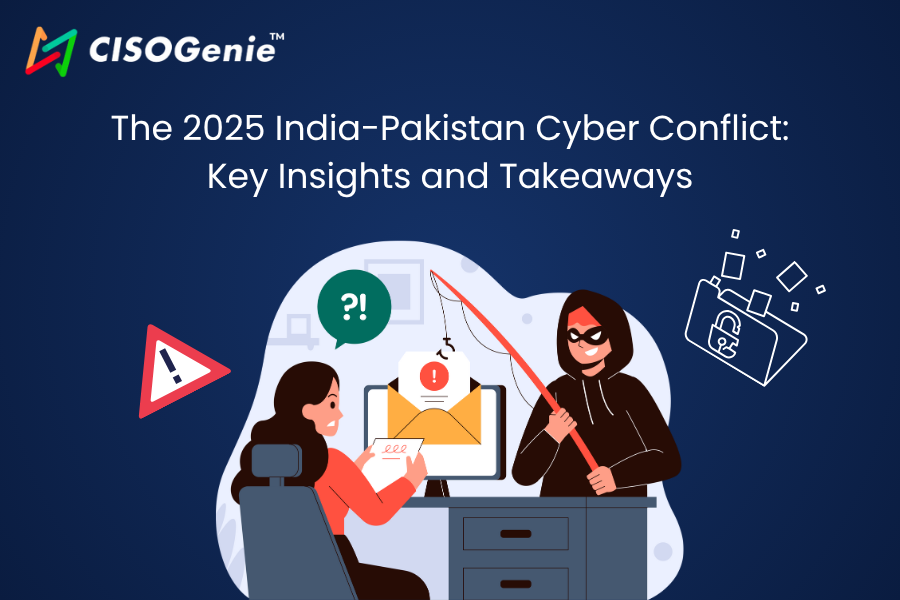The India Pakistan cyber war 2025 unleashed an unprecedented cyber onslaught: over 10 crore (100 million) attempted intrusions and massive DDoS attacks. This conflict underscored a critical truth: cyber preparedness is now a national security imperative.
1. The Cyber Onslaught: Scale & Nature of Attacks
Following the Pahalgam terrorist attack (April 22, 2025) and “Operation Sindoor” (May 7), cyberattacks surged. Indian authorities reported 1.5 million attempted cyber intrusions in just the days following these events, with a cumulative scale reaching around 10 crore (100 million) attempts during the conflict period. The India‑Pakistan cyber war 2025 featured tactics including phishing, malware, website defacements, and DDoS barrages turning cyberspace into a live battleground.
2. Top 3 Attack Vectors: Adversary Tactics
Maximum disruption during the India‑Pakistan cyber war 2025 came from three dominant attack vectors:
2.1. Distributed Denial of Service (DDoS) Attacks
DDoS attacks peaked May 7–10, coinciding with military tensions. Over 75% of DDoS attacks targeted government organizations, averaging 7 attacks per hour at peak. On May 10, DDoS attacks spiked by 9700%, with some lasting 19 hours.
2.2. Phishing and Malware Infections
Phishing infiltrated government and private networks, tricking users into credential theft or malware downloads. CERT-In and Maharashtra police recorded over 10 lakh (1 million) cyberattacks involving malware and ransomware, targeting MSMEs and critical infrastructurewere prime targets.
2.3. Website Defacements and Unauthorized Access
Over 500 Indian entities were targeted, with at least 150 successful intrusions reported. Attackers exploited web vulnerabilities for disruption and disinformation.
In times of war, and even during peace, a nation’s civil and critical infrastructure is what’s usually targeted. In an era where everything is digital and IoT is the norm, the attack on infrastructure doesn’t happen in battlefields, it happens in data centers and the cloud.
Top 3 Sectors Impacted:
The India‑Pakistan cyber war 2025revealed how certain sectors bear the brunt of cyber hostilities:
Government and Defense
Targeted by over 75% of DDoS attacks; suffered website defacements, service outages, and data breaches.
Critical Infrastructure (Power Grids, Ports, Airports, Telecom)
Power grids were targeted, telecom providers like BSNL and transport services faced disruptions.
Finance and Banking
Fintech platforms including UPI, digital wallets, and stock exchanges faced phishing, malware, and DDoS attacks.
3. Are We Ready?
The India Pakistan cyber war 2025 showed us a painful truth: simply buying security tools is a losing strategy.While Intrusion Prevention Systems (IPS), firewalls, and multi-layered defenses like advanced email filtering, sandboxing, MFA, and robust network protections are essential, they are tactical defences. Organizations find themselves in an endless cycle of acquiring security tools, yet still face breaches.
So what would be a strong defense? Given budgets are limited (they always are, aren’t they?) and we need to make the most of it, what’s the best way to decide what tools to have in our arsenal to thwart even a targeted attack?
Well, that’s what the age-old, oft-hated, oft-dreaded word, Governance, Risk & Compliance are for.
While often considered “boring”, GRC is the best way for anyone to build their necessary-and-sufficient lines of defense. Some might wonder how. After all, we are used to saying, “Compliance sucks!”. So, here is how.
GRC isn’t just another tool; it’s the strategic framework that ties all your security investments together. It provides the essential oversight to:
- Prioritize Investments: Instead of an endless tool-buying spree, GRC ensures you invest in security measures that directly address your highest risks and compliance obligations.
- Bridge the Gaps: GRC identifies where your security tools and processes fall short, ensuring comprehensive coverage across IT and OT environments.
- Drive Continuous Improvement: Through structured risk assessments, policy management, and continuous monitoring, GRC builds an adaptive security posture that evolves with threats, rather than just reacting to them.
- Translate Technical to Business: GRC enables clear communication of cyber risk to the executive board, linking security efforts directly to business outcomes like financial stability and operational continuity.
To put it simple, be it in the physical world, or the cyber, there is a standard blueprint:
- Know your gaps
- Plug those gaps
- Have a checklist of actions to do, to avoid new gaps and to ensure plugged gaps remain plugged.
Hey! Where have we seen those before? Yes!! Those are the ‘R’ and ‘C’ of GRC!
Conclusion
The India‑Pakistan cyber war 2025proved it: cyber isn’t just a tech issue anymore. Robust compliance, continuous risk assessments, and lightning-fast incident response are now our nation’s vital armor, right alongside traditional military might. Simply put, being “battle-ready” now means being cyber-ready.




